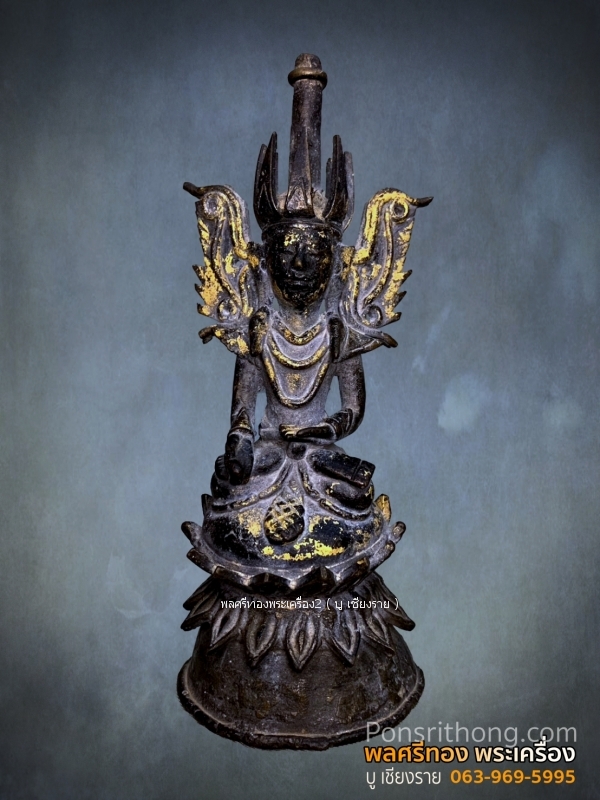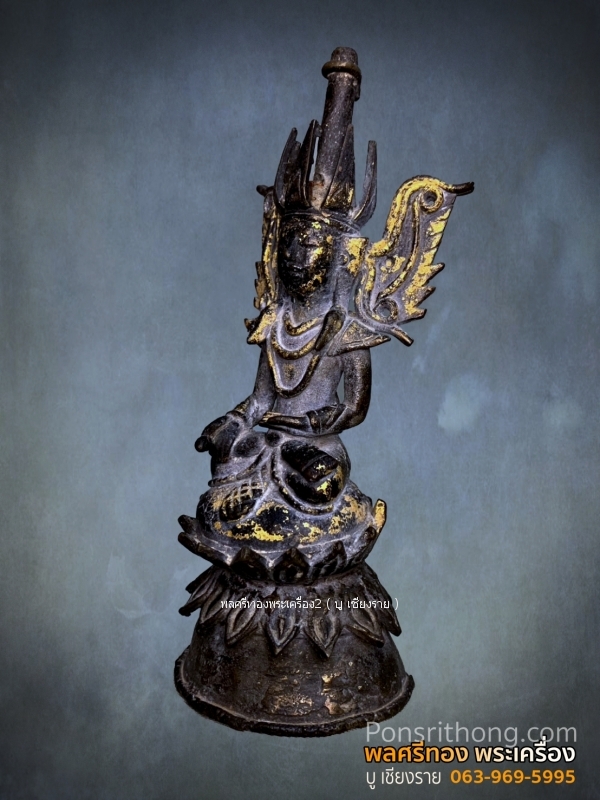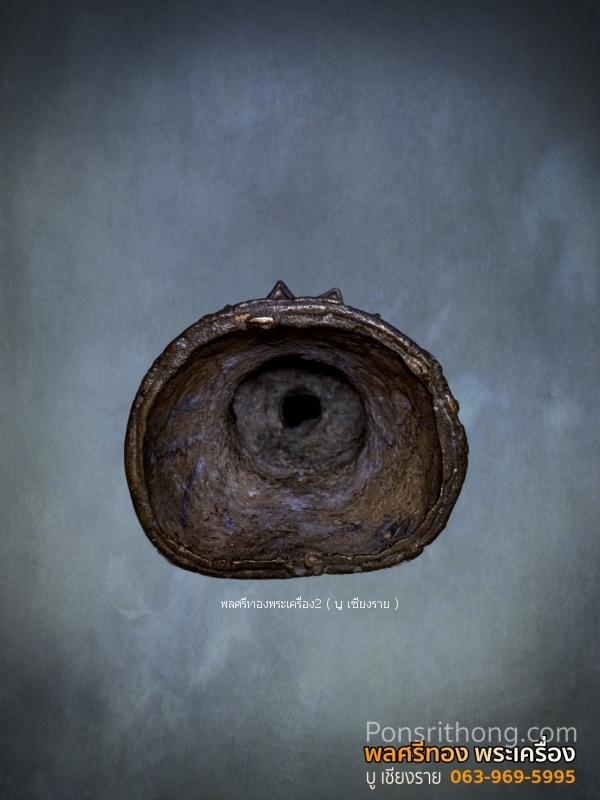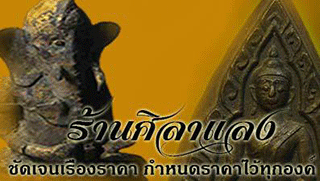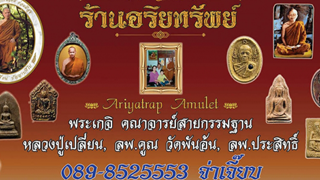พระพุทธรูปพม่า(...
พระพุทธรูปพม่า(ทองสัมฤทธิ์พม่า) จัมภูปาติ ศิลปะชาน
พระพุทธรูปพม่า(ทองสัมฤทธิ์พม่า) ศิลปะชาน Burmese Buddha statue Shan (Tai Yai) style ทรงเครื่องนุ่งห่ม นั่งในท่าดอกบัวขัดสมาธิ สวมมงกุฎหกแฉกวิจิตร ประดับปีกด้านข้าง อุสนิษะปลายแหลมยาว(มีเกตุมาลาที่โดดเด่น)
Shan 18-19 th C Bronze Jambhupati Buddha Statue
หน้าตัก 1.6 นิ้ว
ฐานกว้าง 2.5นิ้ว
สูง 7นิ้ว
พระพุทธเจ้าที่เห็นในอิริยาบถนี้ถือบาตรพระหัตถ์ซ้ายเรียกว่าพระยา มือขวาถือผลไม้จากต้นไมโรบาลาน เชื่อกันว่าผลไมโรบาลัน (ชื่อไทย: สมอพิภก )ช่วยรักษาโรคที่เกี่ยวข้องกับอารมณ์ที่ขัดแย้งกัน ความไม่รู้ ความหลงใหล และความก้าวร้าว
ตำนานของพระพุทธเจ้าทรงจัมภูปติทรงเครื่องราชกกุธภัณฑ์และสวมมงกุฏ เชื่อกันว่ามีมาในสมัยพุทธกาลและเกี่ยวข้องกับการพบปะกับกษัตริย์จัมภูปติผู้เป็นคนนอกรีต ขี้หยิ่ง และหยิ่งยโส มีชื่อเสียงในเรื่องการข่มขู่อาณาจักรและ เพราะวิถีอันโหดร้ายของเขา พระพุทธเจ้าทรงพยายามที่จะเปลี่ยนพระราชาโดยขอให้พระองค์ละทิ้งความชั่วและแสดงความเมตตาแทน แต่พระเจ้าจัมภูปติไม่สะทกสะท้านกับคำขอนี้
พระพุทธเจ้าทรงทราบถึงความไม่เต็มใจของกษัตริย์ที่จะเปลี่ยนวิถีของพระองค์ พระพุทธเจ้าจึงทรงปรากฏกายด้วยเครื่องราชอิสริยาภรณ์อันรุ่งโรจน์จนทำให้พระเจ้าจัมภูปติถ่อมตนลง จึงทรงรับเอาศีลของศาสนาพุทธ แล้วทรงรับพระธรรมแล้วทรงบวชเป็นพระภิกษุ
พระพุทธรูปแบบจัมภูปติยังพบเห็นได้ในสื่อต่างๆ มากมาย แต่จะสวมมงกุฎและสวมเครื่องเพชรพลอยเสมอ พระพุทธรูปสวมมงกุฎไม้และลงรักมักปิดทองและตกแต่งด้วยกระเบื้องโมเสกแก้วและม้วนแลคเกอร์ทาโยเพื่อเป็นตัวแทนของเครื่องเพชรพลอยและจีวรที่สวมใส่โดยพระจัมภูปตี (กษัตริย์)
พระพุทธรูปพม่า ศิลปะชาน (ชาน หรือ ฉาน เป็นคำที่พม่าใช้เรียกคนไทใหญ่)
นิยมสร้างกันมากในคริสต์ศตวรรษที่ 17 ช่วงที่ รัฐฉาน ( Shan state ) กำลังเรืองอำนาจและได้แผ่ขยายอาณาจักร, ศิลปะ และ วัฒนธรรม ไปอย่างกว้างขวาง ซึ่งในยุคนั้นหากเปรียบเทียบก็คือช่วงสมัยอยุธยาของเรา พระพุทธรูปนี้มีศิลปะและเอกลักษณ์โดดเด่นเฉพาะตัวที่ไม่เหมือนกับพระพุทธรูปสมัยอื่น เสน่ห์ของพระพุทธรูปในยุคสมัยนี้อยู่ตรงที่หน้าพระพุทธรูปจะเหมือนเด็กน่ารัก ซึ่งทำให้ผู้ที่เก็บสะสมไว้ ทุกครั้งที่เห็นพระองค์นี้จะรู้สึกมีความสุขและสบายใจอย่างบอกไม่ถูก
-----
The legend of the Jambhupati-style Buddha dressed in royal attire and wearing a crown is thought to have originated during the lifetime of the Buddha and is related to his meeting with the heretic, haughty, and conceited king Jambhupati, renowned for terrorizing his kingdom and for his cruel ways. The Buddha endeavored to convert the King by asking him to forsake his evil ways and instead practice kindness, but King Jambhupati was unmoved by this request.
Realizing the king’s total reluctance to change his ways, the Buddha magically appeared in resplendent royal attire that so humbled King Jambhupati, he accepted the Buddhist precepts, then accepted the dharma and becomes a monk.
The Jambhupati-style Buddha statue is also seen in several different mediums, but always crowned and wearing jewels. The wooden and hollow lacquer-crowned Buddha statues are often gilded and decorated with glass mosaics and thayo lacquer scrolls to represent the royal jewels and robe worn by a Jambhupati Buddha (king).
Shan 18-19 th C Bronze Jambhupati Buddha Statue
หน้าตัก 1.6 นิ้ว
ฐานกว้าง 2.5นิ้ว
สูง 7นิ้ว
พระพุทธเจ้าที่เห็นในอิริยาบถนี้ถือบาตรพระหัตถ์ซ้ายเรียกว่าพระยา มือขวาถือผลไม้จากต้นไมโรบาลาน เชื่อกันว่าผลไมโรบาลัน (ชื่อไทย: สมอพิภก )ช่วยรักษาโรคที่เกี่ยวข้องกับอารมณ์ที่ขัดแย้งกัน ความไม่รู้ ความหลงใหล และความก้าวร้าว
ตำนานของพระพุทธเจ้าทรงจัมภูปติทรงเครื่องราชกกุธภัณฑ์และสวมมงกุฏ เชื่อกันว่ามีมาในสมัยพุทธกาลและเกี่ยวข้องกับการพบปะกับกษัตริย์จัมภูปติผู้เป็นคนนอกรีต ขี้หยิ่ง และหยิ่งยโส มีชื่อเสียงในเรื่องการข่มขู่อาณาจักรและ เพราะวิถีอันโหดร้ายของเขา พระพุทธเจ้าทรงพยายามที่จะเปลี่ยนพระราชาโดยขอให้พระองค์ละทิ้งความชั่วและแสดงความเมตตาแทน แต่พระเจ้าจัมภูปติไม่สะทกสะท้านกับคำขอนี้
พระพุทธเจ้าทรงทราบถึงความไม่เต็มใจของกษัตริย์ที่จะเปลี่ยนวิถีของพระองค์ พระพุทธเจ้าจึงทรงปรากฏกายด้วยเครื่องราชอิสริยาภรณ์อันรุ่งโรจน์จนทำให้พระเจ้าจัมภูปติถ่อมตนลง จึงทรงรับเอาศีลของศาสนาพุทธ แล้วทรงรับพระธรรมแล้วทรงบวชเป็นพระภิกษุ
พระพุทธรูปแบบจัมภูปติยังพบเห็นได้ในสื่อต่างๆ มากมาย แต่จะสวมมงกุฎและสวมเครื่องเพชรพลอยเสมอ พระพุทธรูปสวมมงกุฎไม้และลงรักมักปิดทองและตกแต่งด้วยกระเบื้องโมเสกแก้วและม้วนแลคเกอร์ทาโยเพื่อเป็นตัวแทนของเครื่องเพชรพลอยและจีวรที่สวมใส่โดยพระจัมภูปตี (กษัตริย์)
พระพุทธรูปพม่า ศิลปะชาน (ชาน หรือ ฉาน เป็นคำที่พม่าใช้เรียกคนไทใหญ่)
นิยมสร้างกันมากในคริสต์ศตวรรษที่ 17 ช่วงที่ รัฐฉาน ( Shan state ) กำลังเรืองอำนาจและได้แผ่ขยายอาณาจักร, ศิลปะ และ วัฒนธรรม ไปอย่างกว้างขวาง ซึ่งในยุคนั้นหากเปรียบเทียบก็คือช่วงสมัยอยุธยาของเรา พระพุทธรูปนี้มีศิลปะและเอกลักษณ์โดดเด่นเฉพาะตัวที่ไม่เหมือนกับพระพุทธรูปสมัยอื่น เสน่ห์ของพระพุทธรูปในยุคสมัยนี้อยู่ตรงที่หน้าพระพุทธรูปจะเหมือนเด็กน่ารัก ซึ่งทำให้ผู้ที่เก็บสะสมไว้ ทุกครั้งที่เห็นพระองค์นี้จะรู้สึกมีความสุขและสบายใจอย่างบอกไม่ถูก
-----
The legend of the Jambhupati-style Buddha dressed in royal attire and wearing a crown is thought to have originated during the lifetime of the Buddha and is related to his meeting with the heretic, haughty, and conceited king Jambhupati, renowned for terrorizing his kingdom and for his cruel ways. The Buddha endeavored to convert the King by asking him to forsake his evil ways and instead practice kindness, but King Jambhupati was unmoved by this request.
Realizing the king’s total reluctance to change his ways, the Buddha magically appeared in resplendent royal attire that so humbled King Jambhupati, he accepted the Buddhist precepts, then accepted the dharma and becomes a monk.
The Jambhupati-style Buddha statue is also seen in several different mediums, but always crowned and wearing jewels. The wooden and hollow lacquer-crowned Buddha statues are often gilded and decorated with glass mosaics and thayo lacquer scrolls to represent the royal jewels and robe worn by a Jambhupati Buddha (king).
ผู้เข้าชม
338 ครั้ง
ราคา
โทรถาม
สถานะ
มาใหม่
โดย
ชื่อร้าน
พลศรีทองพระเครื่อง2 ( บู เชียงราย )
ร้านค้า
โทรศัพท์
ไอดีไลน์
@fsd8020u (มี@)
บัญชีธนาคารยืนยันตัวตน
ยังไม่ส่ง ข้อมูลยืนยันตัวตน
